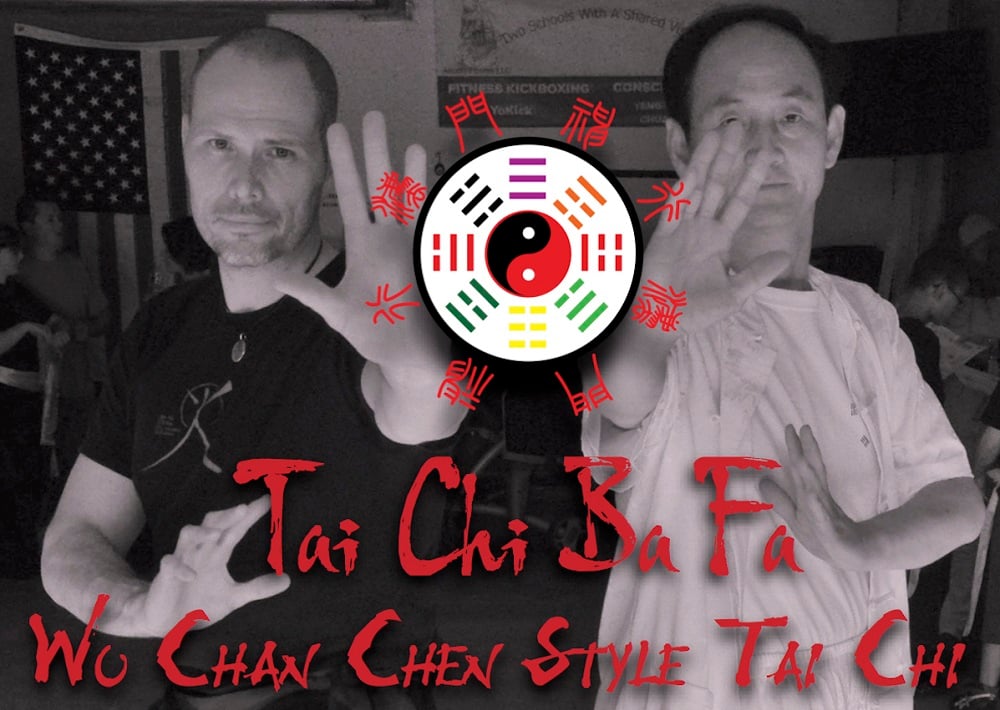In addition to Resilient Stress Management, wherever I currently teach, I teach a style of Gong Fu called Shen Shing Wu Chan. Shen is spirit, Shing is movement, Wu is mixed Chinese martial arts, and Chan is meditation. Together they are “Inspired movement through conflict, while meditating.” I have the unique privilege of studying directly under Master Wang Tian Min, who grew up in China and had the rare opportunity to grow up studying under many Chinese martial arts Masters. Additionally, he studied Chinese medicine, philosophy, and culture: the I Ching, Ba Gua, Yin and Yang, and the Tao. Master Tian synthesized his knowledge and experience into the Shen Shing Wu Chan system. He embodies the art of extending beyond the ordinary limits of life.
He has spent the last 7 years classically training me as a Shi Fu. This includes mastering 4 different systems of Chinese Martial Arts: Taiji, Ba Gua, Gong Fu, and Qi Gong. In additions this training includes. Classical Chinese weapons: Tai Chi Dao, 9 Sectional Steel whip, 8ft spear, staff, Gun Tou Dao, double spear, Guan Dao, to name a few.
Mastery of these systems and forms require a deep understanding of the culture which gave birth to them. Each of the moves and forms has Mandarin names and poetry that connect them with ancient knowledge and cultural meaning.
“Chinese Martial Arts without culture is like a tree with no root.”
―Master Tian.
Master Tian has honored this by teaching me the cultural concepts in Mandarin. We have spent over 2000 hours translating the concepts across cultural and language barriers and realizing them in as many hours of training to calibrate the translations correctly. This way knowing and using agree with each other in a collaborative way across cultural boundaries.
When I met Master Tian, I had been studying Chinese martial arts for over 17 years. I researched and read everything I could find on Chinese martial arts. When I first began studying, the cultural and philosophical foundations of Chinese Martial Arts where, for a host of reasons, largely obscured. The translations that existed were often confusing, incomplete, or conflicting. Always there were arguments over which style or lineage was the best and truest. I have heard many theories as to why this was the case, xenophobia, clan mentality, strategy, conflict, power control. Whatever the reason, the result was an incomplete understanding of Chinese martial arts that has led to stereotypes, and little changed in the 17 years. What I discovered under Master Tian’s instruction was that much of the inaccuracies were often remedied by accurate language translations that are based on shared observations of the same phenomenon and work to find words that translate efficiently across language barriers.

What I discovered under Master Tian’s instruction was that much of the inaccuracies were often remedied by accurate language translations that are based on shared observations of the same phenomenon and work to find words that translate efficiently across language barriers.
Many of the concepts that are essential to Chinese Martial Arts simply have no equal in English. Words like Dao, yin, yang, Ba Gua, Yi, Qi, Jing, Wu De, Xian Ren, Zi Xin, Lu, Dong Tai, to name a few, all require paragraphs of words in English to convey an equal meaning. Observable inspired movement remedies this quickly. You can see and do without having the words and then add the words to deepen and clarify the experience.
The word “Yi” for example, is a core principle that has no English equivalent. Attempts have been made to translate the word Yi as intent, which is correct, but is also a huge oversimplification of the concept. It is akin to saying that “love” means warmth. It’s not wrong, but it is not complete. It took 4 years of consistent training and work before I could successfully demonstrate Yi in my sword form and have Master Tian confirm my expression was correct, “Yes Eddie, you now understand Yi, you will now build power.” Yi is the spiritual precursor to change. It is an expression of an inspired heart and mind. There is no Qi without Yi. The advanced forms of Shen Shing Wu Chan Gong Fu are not possible without robust Yi and Qi. Because of its great importance, we begin with teaching Yi. A student with an open mind can, in a few minutes of exploring, begin to perceive Yi enough to begin working with it. As my student, Liz, is fond of saying, “Minutes to learn, a lifetime of gains to master!”
 Master Tian's Sheng Shing Wu Chan Poetry
Master Tian's Sheng Shing Wu Chan Poetry
It is the culture of Shen Shing Wu Chan that makes it especially valuable for students’ learning. Combining the Mandarin words with the experience of “moving in Mandarin” gives a richer understanding of both. Essentially the forms are vehicles for empowering students with Zi Xin, belief in themselves, and Yi to inspire movement.
Wu De, Yi Da, Zi Xin, these are the keys to personal power and happiness.
One last detail. Gong Fu means time, effort, with attention to detail. At its heart, it refers to a dedicated approach to mastery that inspires character development concurrently with what is being mastered. Many people believe Gong Fu is simply punches and kicks, which is not wrong. Yet it is an incomplete understanding that leads to many stereotypical beliefs about Gong Fu. It is true that Gong Fu trains self-defense as a way of life preservation. However, Shen Shing Wu Chan relies on inspired movements to accomplish this and therefore points to a wider purpose. The purpose of training Shen Shing Wu Chan Gong Fu is to nurture good health and train an inspired spirit to move through stress, conflict, and change while Centered.
The energy you build training Shen Shing Wu Chan applies to life in and out of conflict, with the premise that the more energized you are, the more spirited you are. The more spirited you are, the healthier you are. The healthier you are, the more efficiently you manage stress and conflict without resorting to avoidance and fighting. In this light, it is a proactive solution to self-defense and health defense. This makes Shen Shing Wu Chan a worthy investment of time, effort, and energy.
For many years, I believed I would need to save a small fortune, learn Mandarin, search for a Master, beg him or her to teach me and learn as much as they would teach me in 3 months or so. I am grateful for what Master Tian has graciously shared with me and my students so that we can all benefit and live inspired lives of energy and movement. Master Tian has brought with him 5000 years of culture and a lifetime of Chinese Martial arts experience and training; he has brought China to America. I did not know when I began studying with him, that in addition to the Taiji form, I was going to get an immersion into Chinese culture, that would give me the opportunity to explore and gradually perceive Mandarin and Chinese Martial Arts, philosophy, and culture. It is my intent to continue this tradition throughout the experience of training my students and educating people for life’s demands.
 Combined Efforts-Shen Shing Fa Meng
Combined Efforts-Shen Shing Fa Meng

